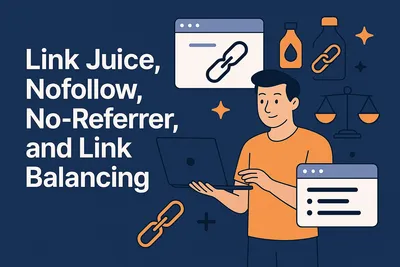Ultimate SEO Checklist for Web Developers: 2023 Complete Guide
Essential Technical SEO Optimizations Every Developer Must Implement

This article is the first installment of an ongoing series of articles I’m writing on search engine optimization from a developer’s viewpoint. The series is meant to be a quick, bite-sized bundle of information that developers can immediately apply to their websites without any previous SEO experience.
For this piece, we’ll start with some obvious ones. Don’t skip it, though, because you’re probably wrong if you thought the title, description, and meta tags were enough and accurate representations of what will appear on search results. This article contains information we often have to pay for to maintain SEO rankings and is part of the important checks that many paid SEO tools include.
Title and Description
bonusDid you know that if you put no effort into the title, Google search shows something off the page? It’ll usually be the top-level heading. For example, if you place a word or two as a page title in the
titletag, chances are that Googlebot would instead use a header from the page.
Don’t skip the effort on the title.
When we think of titles in the context of search engine optimization, our first thought may be to cram in as many keywords as possible. As logical as it might seem, the title is a one-line pitch we put on the internet that catches the user’s attention while scrolling through the search results. A title that grabs attention doesn’t always have to be dramatic. It can be an unambiguous and brief representation of the content to expect. Because good SEO doesn’t only mean click-through but should also result in minimum bounce rate. We want users that would like to revisit the website.
As far as the crawl bots are considered, we must ensure that the top-level header and the webpage title are different. Keeping them precisely the same may have a negative impact, however minor, on the ranking of our webpage. The duplication might look like we’re trying to push the keywords as much as possible.
One effortless thing is to append the site name at the end of the title. Either separated by a hyphen or a bar. This is particularly useful for blog pages. For example, look at this page’s title or any other article on this website. We’d see a suffix added to the article’s title, indicating the page category it belongs to. If you go to the home or contact page, you’d see a different suffix.
So it helps keep a distinctive title while adding more meaning.
Descriptions can be lightweight.
A website’s description can be a manageable length. Because only a tiny part of it would appear on the search results. A 50-80 characters long description is generally a good choice, although it can be higher than that. They’re like a supporting dialogue to the one-line pitch we call title. The content is what we are “selling”, as in our product. A title can draw the attention, while a description can give them enough information to decide if they will click. And more often than not, the latter will be the edge. The whole point of search engine optimization is to get a chance to build credibility.
Another thing to note is that there might be an inclination to try and put all the keywords. While keywords are important, it is better to have a good balance. One way is to use synonyms or closely related words in the description if we’ve already placed the keywords in the title and URL. This also helps boost our chances of landing in the search results for related Google searches.
Do not duplicate descriptions across your website’s pages. Have a uniquely crafted, no matter how small or big. But a uniquely crafted description for each page. We don’t want the search engine to think we have duplicate content across our web pages and, thus, a bit spammy.
Keywords and metadata
Keywords are essential; we all know that. But how do we know what to use? Or how to use it? Or where to put it? Let’s talk about that.
Keywords are more complex than we think.
Keywords meta used to be a big deal, but the general consensus is that it no longer carries much weight. Although, too many keywords in the meta tag can negatively impact the website’s ranking. Instead, we should use them within the content. Sometimes, I use short phrases or combination of words in my keywords meta that have higher chances. Instead of focusing on the meta tag for keywords, a better way to go about it is to secure the target keywords that appear in the title, description, and phrases in the meta tag and then ensure that those keywords are used in the main content.
That doesn’t mean we start cramming and overusing those words in the main content.
noteThe objective of proper SEO is to get our website the correct exposure and clicks. And the purpose of a website is to retain the users.
So content quality matters as much as keyword optimization. You can also use Google’s keywords planner to research keywords ideas.
Meta tags
It is important to have metadata for social media websites to display your website’s information in a more structured way. I say important because as much as organic search traffic is our goal, we usually start marketing it through direct channels like LinkedIn, Twitter, or Facebook. Or someone lands on our website and shares it on social media. In that case, the page’s meta tags will provide enough information to the website and present the details better.
metatags.io is a great place to check your website’s metadata tags for popular websites. You can also find the correct property names and values in their documentation.
This is all for this part of the SEO series since too much information at once can be exhausting to consume and retain. In the coming parts of this series, I’ll be writing about the following:
- Crawling and Indexing, Bots and Sitemaps
- Link ratios (Internal vs. External, Good vs. Bad backlinks, and more)
- Text to Code ratio
- Mobile usability and PageSpeed
- JSON-LD structure
- Microformats and Microdata
Since SEO rules are constantly evolving along with the web, if you find anything new or updated, do drop in a text or on any of my social media profiles linked in the bottom of this page. I would love to edit the article so it keeps helping people quickly and concisely because quality content shines more in the endless sea of digital content.





